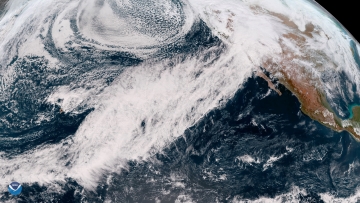690323_1_Atmospheric Rivers_360 px width.jpg

Satellite image of an atmospheric river that drenched California with heavy precipitation. Credit: NOAA
Many Americans have learned a new term in the past few years: atmospheric river. Massive ribbons of water vapor have brought floods and epic snowfalls to the West Coast. And our warming climate could produce more intense examples in the years ahead.
An atmospheric river begins as warm ocean water evaporates and climbs into the sky. It forms a stream of water vapor that surfs along with the weather. It can be a few hundred miles wide and a thousand miles long, and carry several times more water than the Mississippi River.
When the river hits land, mountains push it higher. The water vapor cools and condenses, forming clouds, rain, and snow.
Atmospheric rivers are found all over the world—roughly a dozen are flowing at any time. In recent years they’ve brought record floods to Iran, Australia, and other regions. But they’re most common in North America, New Zealand, and parts of Europe and Africa.
In late 2021, they caused major flooding in western Washington. And in the winter of 2023, a series of major rivers pounded California, with hurricane-force winds, high waves, and flooding rains. Some areas received more than three feet of rain, washing out roads and bridges. And record snowfall trapped people in the Sierra Nevada Mountains for days.
In the coming decades, our warming climate will produce more ocean evaporation. Forecasts say that won’t produce more atmospheric rivers, but it will make them more intense—bigger threats for America’s West Coast.

